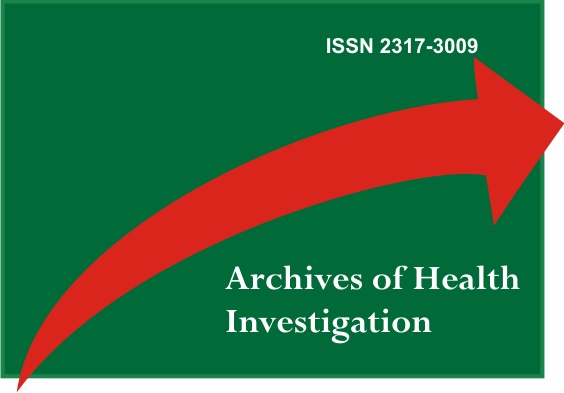Dento-Alveolar Trauma: Hard Dental Tissues, Polpa and Alveolar Process
DOI:
https://doi.org/10.21270/archi.v11i1.5386Keywords:
Tooth Injuries, Diagnosis, TherapeuticsAbstract
Introduction: Crown fractures are the most common of all traumatic dento-alveolar injuries and mainly affect the anterior permanent teeth. They are classified as enamel fracture, enamel / dentin fracture with or without pulp exposure, coronary root fractures and root fractures. Objective: To carry out a literature review about injuries to the hard tissues of the teeth and pulp, highlighting from clinical and etiological aspects to treatment. In addition, in the present study, fractures of the alveolar process and aspects related to immobilization of the dento-alveolar traumas they need will also be described. Methods: A bibliographic search was performed in the PubMed / Medline, Scielo and Google academic databases, using publications from the last 10 years as a filter. The search was carried out with previously selected descriptors. The research took place in 3 phases and the articles were included according to the inclusion and exclusion criteria. Results: Lesions to dental hard tissues and pulp can be classified from a simple crack of enamel where there is no loss of dental tissue to root fractures where treatment can be complex and even require immobilization of the affected tooth. Fractures of the alveolar process are often associated with dental trauma and may require a more complex approach than simpler fractures. Conclusion Fractures of the dental and pulp hard tissues are the most commonly found within all injuries caused by dento-alveolar trauma. It is important that the professional performs an adequate diagnosis as well as monitoring these injuries.
Downloads
References
Cavallli MA, Oliveira BO, Nuernberger PVF, Cristófaro M, Cadioli IC, Wanderley MT. Colagem de dente permanente com fratura sem exposição pulpar. Clin lab res dent. 2014;20(2):110-16.
Gerard LN, Martos J, Baldisserra RA, Lund RG. Reabilitação estética em dente anterior com extensa fratura coronária: relato de caso. Rev Fac Odontol Lins. 2014;24(1):58-63.
Traebert J, Claudino D. Epidemiologia do Traumatismo Dentário em Crianças: A Produção Científica Brasileira. Pesqui Bras Odontopediatria Clín Integr. 2012;12(2):263-72.
Malmgren B, Andreasen JO, Flores MT, Robertson A, Diangelis AJ, Andersson l, et al. International Association of Dental Traumatology guidelines for the management of traumatic dental injuries: 3. Injuries in the primary dentition. Dent Traumatol. 2012;28(3):174-82.
Diangelis AJ, Andreasen JO, Ebeleseder KA, Kenny DJ, Trope M, Sigurdsson A et al. International Association of Dental Traumatology guidelines for the management of traumatic dental injuries: 1. Fractures and luxations of permanent teeth. Dent Traumatol. 2012;28(3):2-12.
Guedes Pinto AC. Odontopediatria. 9ed. São Paulo: Santos; 2016.
Pogrel MA, Kahnberg KE, Anderson L. Cirurgia bucomaxilofacial. Rio de Janeiro: Santos; 2016.
Hupp JR, Ellis III E, Tucker MR. Cirurgia oral e maxilofacial contemporânea. 5ed. Elsevier: Rio de Janeiro; 2015.
Baratieri LN, Monteiro Jr S. et al. Odontologia Restauradora – Fundamentos e Possibilidades. 2ed. São Paulo: Santos; 2015.
Conceição EN. Dentística Saúde e Estética. 2ed. Porto Alegre: Artmed, 2007.
Garcia FCP, Poubel DLN, Almeida JCF, Toledo IP, Poi WR. et al. Tooth fragment reattachment techniques—A systematic review. Dent Traumatol. 2018;34(3):135-43.
Baratieri LN, Monteiro Jr S, Melo TS. et al. Odontologia Restauradora: fundamentos e técnicas, volume 1. São Paulo: Santos, 2013.
Fonseca RJ, Walker RV, Barber HD, Powers MP, Frost DE. Trauma Bucomaxilofacial. 4ed. Rio de Janeiro: Elsevier; 2015.
Miloro M, Ghali GE, Larsen PE, Waite PD. Princípios de cirurgia bucomaxilofacial de Peterson. 3ed. São Paulo: Santos; 2016.
Rangareddy MS, Daga A, Vardhan VV, Daneswari M. Management of Root Fracture: A Novel, Noninvasive Treatment Approac. Case Rep Dent. 2013; 653261.
Kobayashi-Velasco S, Salineiro FCV, Gialain JO, Cavalcanti MGP. Diagnosis of alveolar and root fractures: an in vitro study comparing CBCT imaging with periapical radiographs. J App Oral Sci. 2017;25(2):227-33.
Cantore S, Ballini A, CRincoli V, Grassi FR. Treatment of horizontal root fracture: a case report. Cases J. 2009;2:8101.
Andreasen JO, Lauridsen E. Alveolar process fractures in the permanent dentition. Part 1. Etiology and clinical characteristics. A retrospective analysis of 299 cases involving 815 teeth. Dent Traumatol. 2015;31(6):442-47.
Lim L, Sirichai P. Bone fractures: assessment and management. Aust Dent J. 2016;61(supl. 1):74-81.
Macleod SP, Rudd TC. Update on the management of dentoalveolar trauma. Curr Opin Otolaryngol Head Neck Surg. 2012;20(4):318-24.
Prado R, Salim M. Cirurgia bucomaxilofacial: diagnóstico e tratamento. 2ed. Rio de Janeiro: Guanabara Koogan; 2018.


